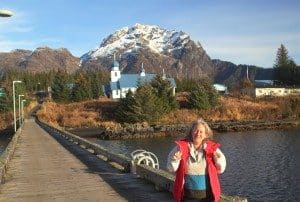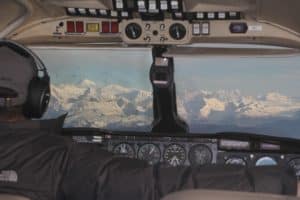Explorations in Competency Education
CompetencyWorks Blog

This post introduces the upcoming series on Chugach School District.
I learned a lot during my trip to Alaska to visit Chugach School District and Highland Tech Charter School. If a moose licks his lips at you, it’s time to back away carefully. Slowly wave your arms if a black bear comes your way. Get on your belly and cover your neck if a brown bear shows more than a passing interest in you. However, there is no advice if you encounter a grizzly! (I did encounter a moose in Anchorage’s Kincaid Park, including a bull, who did, in fact, a bit of lip-licking.)
It makes sense that one of the places that competency education developed is in the Alaskan landscape. Alaska is about the essentials. Alaska requires adaptability. And with the incredible mountains all around, peeking out here and there from the clouds, one cannot be anything other than humble. Humility is the breeding ground for competency education. It is humility that allows all of the adults to become learners rather than decision-makers, experts, and teachers. It is humility that creates school cultures that embrace the concept of ‘not yet.’ Students may not yet be proficient. More importantly, educators may not yet know what students are capable of or how to best support their learning.
It’s this combination of the essentials, adaptability, and humility that is required to go forth to redesign our education system without knowing exactly how the pieces fit together, let alone which pieces are required in the first place. We just know it’s important to do better than we are doing now for the sake of our children.
This is the beginning of a series of posts on my trip to Alaska to visit Highland Tech Charter School (HTC) and Chugach School District (CSD). In this post, I share a bit about my trip and a few of my big takeaways. In future posts, I’m going deep into CSD, as there is so much to learn from them. CSD has been staying the course for nearly twenty years, and we’ll look at how they began the process of transformation; the structure of their performance-based system; the experience of teachers; how they structure their district so that it works for all students and cultures, including the important influence of the Alaska Native culture upon the education system’s development; lessons learned for small, rural schools; and implications for homeschooling.
Three Big Leaps
Overall, my understanding of competency education took three big leaps during my visits.
- Creativity: Competency education unleashes teachers’ and students’ creativity. (Or, at the very least, it can, provided teachers and school leaders have the courage and supports to explore new ways for students to learn and demonstrate their learning.) Over and over, teachers referred to the fact that in the beginning, they just didn’t realize how many other ways there are to construct the learning cycle. And how daunting it seemed in the first year, and how meaningful it is as they continue to build their skills. As I talked to teachers in each of the schools I visited, I came to understand that competency education is going to create more flexibility than I had imagined.
- Comprehensiveness: When I started learning about competency education, separating academics from behaviors in grading systems was such an enormous change. And of course it is. Yet, HTC and CSD taught me that the bifurcation of academics and behavior is just a baby step. By having a comprehensive, whole-child approach that recognizes all the domains of learning across the age span, we can deeply embed child and youth development into the school system. Furthermore, by creating structures that recognize all aspects of learning (including culture, career development, and technology) along with the core academic standards and those powerful habits and higher-order thinking needed for deeper learning, we reduce competition for the curriculum. Whole child, whole learning.
- Balance: Creating nimble, agile education organizations means that management teams at the school and district level need tools that help them key an eye on how the organization is shifting. If we a) want to have students become proficient along an entire learning progression and b) also want them to have opportunity to apply their learning through projects and inquiry, then we need a sense of how to keep this in balance. And if the goal is to prepare students for lifelong learning and not just graduation, we are going to have to value those domains equally – even if national and state policies assert that only English language and math are important enough to be measured. To avoid more top-down summative assessments, superintendents and principals are going to have to ensure their organizations value lifelong learning and have the skills and tools they need to stay balanced.
Chugach School District
My first day at Chugach School District was spent at their headquarters in Anchorage. I spent time with Dr. Bob Crumley, Superintendent, and Debbie Treece, Director of Special Education. I had a conversation with homeschool teachers and a discussion with the administrative staff about their roles in a remote school district, and also took a visit to the Voyage to Excellence Statewide Residential School.

I accompanied Treece on a visit to Whittier on a snowy, snowy day. After the slippery ride on the Seward Highway bordering the Cook Inlet, into the Portage Valley, and through the second longest tunnel in North America, we entered a town tucked between steep mountains and the entrance to Prince William Sound. In front of us was the harbor (the most northern non-freezing, deep water harbor in the United States, as Whittier was once a military base) with a gaggle of boats that have to be swept of the snow in winter, otherwise they’ll sink under the weight, as well as all the closed-up tourist storefronts. A restaurant and small grocery store remain open for the 300 or so souls who live there year-round (it jumps up to thousands in the middle of summer). Brutalized by the 1964 earthquake, the remains of the officers’ residence lean against the side of the mountain, now offering itself as a bear hotel in the winter. The Begich Towers Condo, a fourteen-story apartment building, overlooks all of Whittier and houses 80 percent of the winter residents, including the majority of the teachers. An underground tunnel connects the condos and the school.

Whittier Community Schools (WCS) usually serves between thirty-five and fifty students PreK–12 with a staff of three certified teachers: Erika Thompson, Lindsey Erk, and Melody Clifford (Head Teacher), as well as multiple classified support staff, including Mandy Sullivan, filling the role of preschool aide for several years. The school is multicultural with a mix of Native Alaskans, Pacific-Islanders (several families from Guam and Samoa have moved there recently), White, and multi-ethnic students. I visited several classes where students were working in different configurations: online (once you reach level 5, you get a laptop), independently, in small group, and in full group. Thompson’s class of third to sixth graders provided me a tour of the school, including their hydroponic garden project.
While in Whittier, I had a chance to speak with school board member Andrea Korbe. She provided valuable insights about the importance of how ownership needs to be focused around the whole, not the individual (a sentiment later reinforced in my conversation with Crumley). She explained that even though each of the schools is geographically isolated from the other, school board members think about how decisions will impact the entire school district.

The next day, with the snow gone and the sun bursting, I boarded an eight-seater plane with Doug Penn, Districtwide Principal, and Judy Youngquist from the Alaska Statewide Mentor Program. Flying over the white-topped Alaskan Mountain Range, over glaciers, past the inlet to Valdez, and into the islands of the Prince William Sound, we found our way to the Alutiiq village of Tatitlek (population around 100), which rests below Copper Mountain. At the airport, we loaded up a truck with groceries we had brought for the Halloween party, and drove a short half mile through the village, past the Russian Orthodox Church with its trio of blue domes, to the Tatitlek Community School (TCS).
Three certified teachers: Jed Palmer (Head Teacher), Ashley Reeves, and Nichole Palmer, and preschool aide Anna Gregorieff work with nineteen students PreK–12. The highest enrollment in the last decade was thirty-four students. On the day I visited, most of the high schoolers were away at the Native Youth Olympics. The older students were working independently, consulting their teacher, as needed. In an elementary school class, the teacher was using direct instruction to teach math to a mixed age group. Down the hall, a group of eight preschoolers was very busy building things as only four year olds can build.
Highland Tech Charter School
Rick Schreiber, Executive Director, Reinventing Schools Coalition, advised me to visit Highland Tech Charter School (HTC), as it was one of the most developed schools in their network. I immediately knew that something was working really well when I walked into the big common area to find twenty students, laptops in hand, disbursed in small groups or busy with independent work. Every single one of them could tell me where they were in their learning, the goals of their work, how they would know when they reached proficiency, and the steps in the process.
HTC is working through the process of integrating a ‘standards-based’ structure, student empowerment, project-based learning, and inquiry-based pedagogy. Michael Shapiro, the new principal, and Ayme Johnson, Assistant Principal, were candid about the strengths, the opportunities, the bumps, and the challenges of their approach. While in Anchorage, I also had a chance to talk with Ginger Blackmon, the previous principal and now professor at University of Alaska-Anchorage College of Education, who provided insights into Alaska and how competency education has been taking root (or not). See posts on HTC and the advice from HTC students for more.
Overall, the visits were an incredible experience, and there was a lot of information to sift through. For a deeper look, stop by for tomorrow’s two-part series describing Chugach School District’s performance-based system.